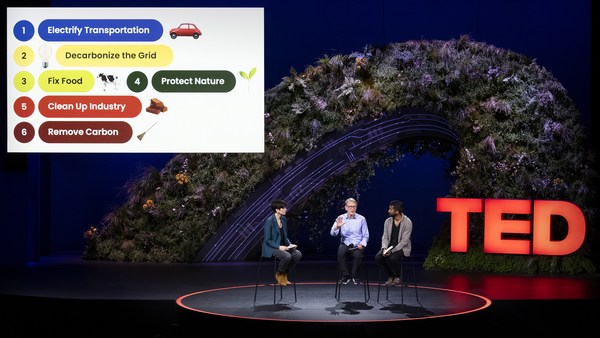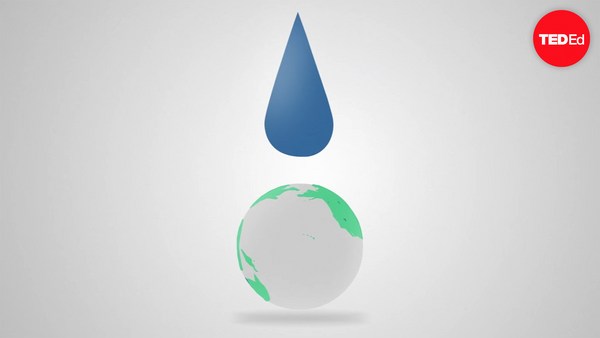A few years ago, I sailed on a ship that comes from an earlier era, when moving goods by sea didn't mean polluting the planet. Our voyage to the Caribbean was eye-opening, and not just because I learned that apparently, I’m incurably seasick.
(Laughter)
I also saw what it's like when you take away the diesel fumes and the black smoke that spew from today's freighters and ports. Instead, our vessel smelled like fresh sea breeze and the bags of cardamom we carried and all that camomile tea I was chugging. Nearly every modern cargo ship relies on highly polluting fossil fuels. Fortunately, there's a way to clean up the industry, beyond just reviving old-fashioned sailing ships, and it's ... green ammonia.
If you know anything about ammonia, it's probably that it's stinky, it's toxic, it's potentially explosive. So it's a great place to start, right? Ammonia is mainly used today to make chemicals and fertilizers. But for many reasons, industry experts are convinced that ammonia could be a game-changing way to drive giant cargo ships, and that it could be used safely and be cost-competitive. Tens of thousands of freighters crisscross the oceans every day, bringing the food we eat, the clothes we wear, the cars we drive. Container ships alone carry some four trillion dollars worth of goods by sea every year. That's roughly the GDP of Germany. At the same time, the shipping industry contributes a significant share of the world's annual greenhouse gas emissions. If shipping were a country, it'd be the sixth largest emitter of CO2, trailing just behind Japan. And as world economies grow and populations rise, shipping's emissions are expected to soar, unless the industry charts a cleaner course.
Green ammonia really first came to my attention in 2017, at the UN Climate Change Conference in Bonn, Germany. At the panel I attended, ammonia seemed kind of like an aside, or something we should be keeping tabs on. Since then, the industry has really coalesced around ammonia as the next dominant shipping fuel. Chemical companies and investors are spending millions of dollars to build green ammonia plants, and shipbuilders and manufacturers are busy developing the necessary technology. The first ammonia-powered ships are just around the corner.
So what's so special about this pungent gas? Well, to start, ammonia doesn't contain any carbon molecules, so it doesn't create carbon dioxide when used as fuel. Instead, it contains one part nitrogen -- which is the main component of air -- and three parts hydrogen, which is a building block of water. It's possible to make ammonia without using any fossil fuels. That's what makes it "green" ammonia. Think of it like this: instead of the oil wells and petroleum refineries that make today's dirty diesel fuels, picture solar panels or wind turbines or hydropower plants. Renewable electricity is the foundation of this whole ammonia-making ordeal. We can start with electrolysis, which uses electricity to split water into hydrogen and oxygen. Then, renewables can power the process that separates nitrogen from air. And so with our hydrogen and nitrogen, we can combine the two in an industrial process at high temperatures to make NH3 -- ammonia.
Now, if you want to use this ammonia to power your thousand-foot-long freighter, you have two options. The first is an internal combustion engine, so similar to how diesel is used in ships today but with certain modifications. Experts think that the first vessels to use ammonia in their engines will be chemical tankers, because they already carry it in their cargo holds. So they'll be like the early adopters. The next options is to use a fuel cell. Fuel cells create electricity through a chemical reaction, and that's what drives the ship's motors and turns the propellers. In Norway, work is underway to launch the world's first ammonia-fuel-cell ship in just a few years' time.
So we can make green ammonia, and we can use it in fuel cells or engines. The final piece of the ammonia puzzle is the infrastructure: the storage facilities, the pipelines, the distribution networks -- everything that's needed to ensure a ship can fill its tanks anywhere in the world. And none of this is particularly novel, because we already have infrastructure for the chemical and fertilizer industries. Now it just needs to be built near ports, and at a global scale -- and with great caution.
So what's needed to take ammonia mainstream? We can draw a rough parallel to the rise of electric cars. A decade ago, about 17,000 EVs were on the roads worldwide. Then, more and more countries adopted policies, encouraging people to buy EVs, supporting manufacturers and to build up charging infrastructure. And as sales climbed and production boomed, the cost of batteries and other components plummeted, making it easier for more people to afford electric cars. So now, instead of 17,000 EVs, it's more like 10 million, and green ammonia could follow a similar path in the shipping industry. Policies to curb emissions and incentivize green investments could spur a shift away from fossil fuels. And as ammonia catches on, fuel prices and technology costs could decline in step, enabling more ship operators to make the switch. And while all of that is happening, a much bigger story will be playing out on the global scale: the rising development and plunging costs of renewable energy supplies. Giant offshore wind farms, sprawling solar arrays and other technologies could provide the electrons needed to make that green ammonia.
Green ammonia might be the main fuel source on future cargo ships, but it doesn’t have to be the only clean technology onboard. Ships will likely use a combination of tools. Batteries can already power the lights and equipment on giant ships, and certainly, smaller vessels can be fully battery-powered today. Design fixes, like supersleek hulls and dolphin-like flippers, can improve ships' efficiency. And another technology that's quickly gaining traction is called "wind-assisted propulsion," which puts a modern twist on an old idea of harnessing wind. One cargo ship I sailed on in the North Sea uses devices called "rotor sails." These are 60-foot-tall tubes that spin around like hyperactive barber's poles, which produces a forward thrust and reduces demand on the diesel engines. It's really exciting to see these things whip around, but it's funny how almost blasé the crew was about the whole thing. They push a button, the tubes swirl to life, the ships saves fuel, and they can all carry on with their normal tasks, as we sailed from Rotterdam to this industrial eyesore in northern England, and back again. Meanwhile, of course, I spent my time admiring the sails, and then curling up in the fetal position as the sea knocked our ship around.
The maritime industry is at a pivotal moment in its long and storied history. Over the last few centuries, fossil fuels have powered the freighters that have transformed global trade, connecting cotton fields to far-flung garment factories and bringing blueberries from one side of the equator to the other. Coal-powered steamships made it possible to travel farther and faster, and diesel engines took this into overdrive. What began in the early 20th century as a humble canal boat puttering along with this tiny engine has since become giant container ships that stretch as long as skyscrapers stand tall. We know that to keep the planet from warming further, we must completely transform the way that we power our homes, our cars and the freighters that bring us all our precious stuff. The shipping industry must join the rest of the world in addressing climate change, and it could do that with the help of green ammonia.
Thank you so much.
(Applause)





